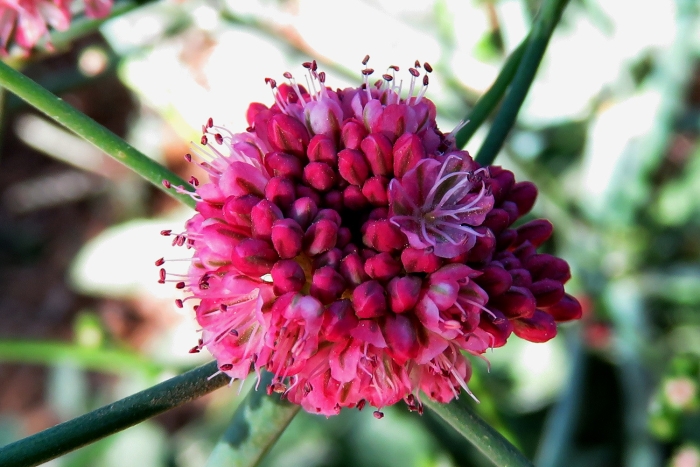Redflower Buckwheat
(Eriogonum grande)
Redflower Buckwheat (Eriogonum grande)
/
/

Vahe Martirosyan
CC BY 2.0
Image By:
Vahe Martirosyan
Recorded By:
Copyright:
CC BY 2.0
Copyright Notice:
Photo by: Vahe Martirosyan | License Type: CC BY 2.0 | License URL: https://creativecommons.org/licenses/by/2.0/ | Uploader: Vahe Martirosyan | Publisher: Flickr |


















































Estimated Native Range
Summary
Eriogonum grande, commonly known as Redflower Buckwheat, is a perennial herb that is part of the unique flora of northwestern Baja California and the Channel Islands of California. It is a mat-forming species that thrives in coastal sage scrub and chaparral habitats, often found on rocky slopes and bluffs. This plant typically forms low, dense mats of foliage with leaves that are mainly basal, wavy along the edges, and can grow up to 10 centimeters long. The stout inflorescences rise above the foliage, bearing clusters of showy flowers that can be white, pink, or red, blooming from spring to summer.
Redflower Buckwheat is valued for its drought tolerance and its ability to attract pollinators, including bees and butterflies, making it an excellent choice for xeriscaping, rock gardens, and native plant landscapes. It is also used for erosion control on slopes. In cultivation, it requires minimal maintenance, preferring full sun exposure and well-drained soils. While it tolerates a range of soil types, it does best with low water once established, reflecting its adaptation to arid conditions. There are no major disease problems, but overwatering can lead to root rot.CC BY-SA 4.0
Redflower Buckwheat is valued for its drought tolerance and its ability to attract pollinators, including bees and butterflies, making it an excellent choice for xeriscaping, rock gardens, and native plant landscapes. It is also used for erosion control on slopes. In cultivation, it requires minimal maintenance, preferring full sun exposure and well-drained soils. While it tolerates a range of soil types, it does best with low water once established, reflecting its adaptation to arid conditions. There are no major disease problems, but overwatering can lead to root rot.CC BY-SA 4.0
Plant Description
- Plant Type: Subshrub, Shrub
- Height: 0.5-1.5 feet
- Width: 0.5-0.7 feet
- Growth Rate: Moderate
- Flower Color: Pink, Red
- Flowering Season: Fall, Spring, Summer
- Leaf Retention: Evergreen
Growth Requirements
- Sun: Full Sun
- Water: Low
- Drainage: Slow, Medium, Fast
Common Uses
Bee Garden, Bird Garden, Border Plant, Butterfly Garden, Deer Resistant, Drought Tolerant, Fire Resistant, Fragrant, Groundcover, Low Maintenance, Potted Plant, Salt Tolerant, Showy Flowers, Street Planting
Natural Habitat
Native to coastal sage scrub and chaparral habitats of northwestern Baja California and the Channel Islands of California
Other Names
Common Names: Red-Flowered Buckwheat, Island Buckwheat
Scientific Names: , Eriogonum grande, Eriogonum grande var. grande, Eriogonum grande subsp. grande, Eriogonum latifolium subsp. grande, Eriogonum nudum var. grande,
GBIF Accepted Name: Eriogonum grande Greene